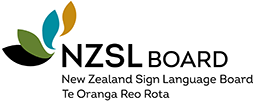About the NZSL Board's Language Planning Priorities
-
The 2017 review showed that the Strategy needed to more clearly describe the language planning priorities for NZSL. Further research identified five internationally recognised language planning priorities that the Board has based this Strategy on (Hornberger, 2009).
- Acquisition: The learning of a language by children and adults.
- Use/Access: The ability to use a language in any or all domains of society, including within whānau.
- Attitude: The beliefs and opinions of language users and others towards that language.
- Documentation: The systematic recording of language use for research and reference.
- Status: How a language is regarded by its users and others.
-
Acquisition and use/access are the two key language priorities within the Strategy due to the importance of Deaf and other NZSL users being able to fully learn and use NZSL in all domains of society. The remaining three language priorities - attitude, documentation and status, play essential supporting roles for achieving NZSL acquisition and use/access.
-
A summary of the NZSL Board's Strategy planning framework is below.
Image description: the summary of the NZSL Strategy Planning Framework outlines the role of the NZSL Board and illustrates how it uses the NZSL Strategy to support the five language planning priorities: acquisition, use/access, attitude, documentation and status.
Page last updated:
